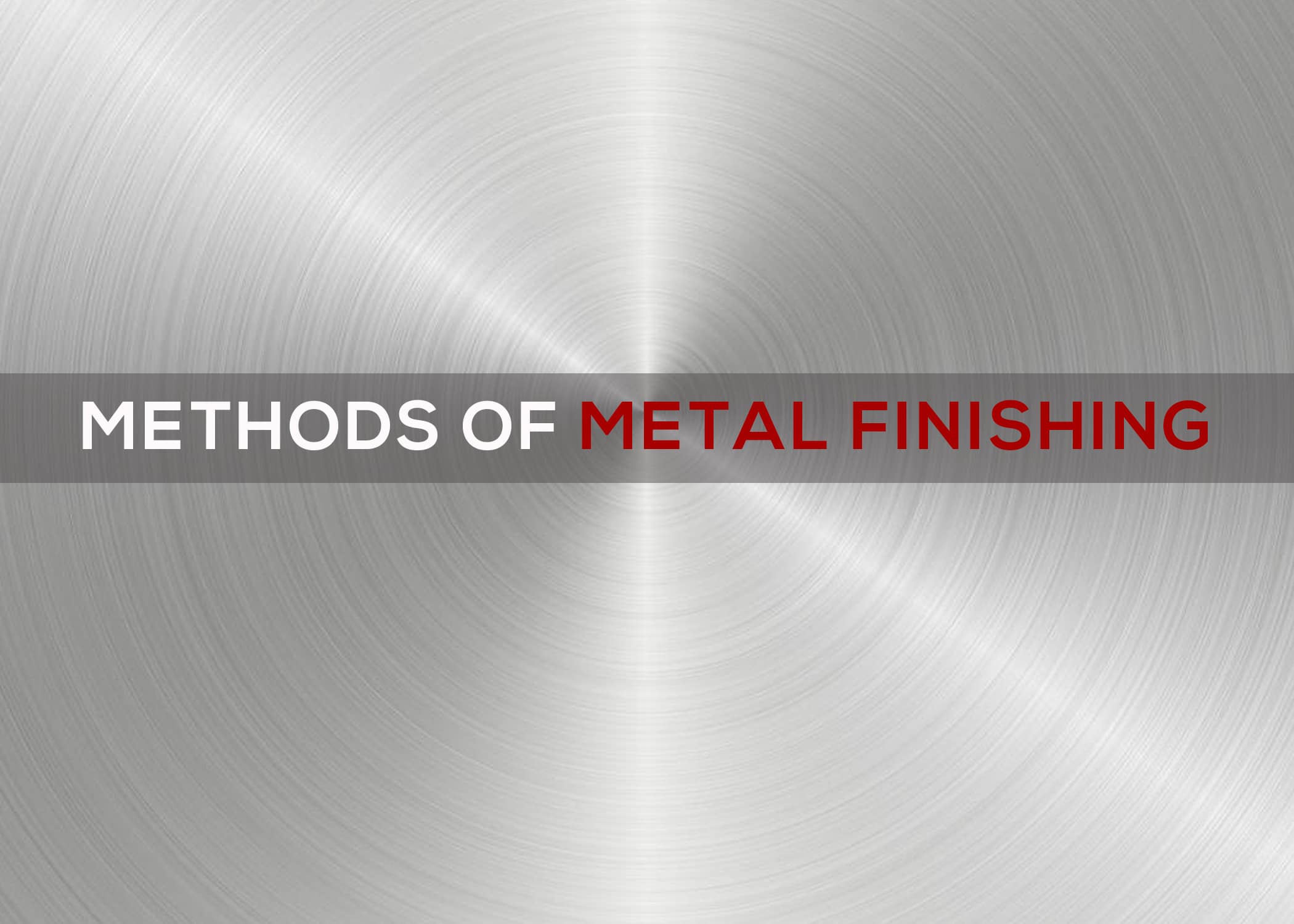“Finishers Wanted”
The 1902 newspaper ad read, “Finishers Wanted — First-class finishers for architectural wrought-iron work.” As long as there has been metalworking, there has been metal finishing, though the concept of finishing has existed much longer than that. Early craftsmen found that once a device or dwelling had been constructed there was still additional work that could be done to make it more functional or attractive. From woodworking to concrete laying, finishing work is always considered an essential step to finalizing projects. Even at a bakery, once the oven is cooling there are still “finishing touches” to be added to a newly created birthday cake.
Whether it’s structural steel work, jewelry crafting, or aerospace applications, virtually every kind of metalworking includes metal finishing to help improve the workpiece. Besides removing surface defects and improving a part’s appearance, finishing a metal surface can also:
- Impart higher resistance to corrosion and chemicals
- Increase durability and wear resistance
- Increase or reduce the effects of friction
- IIImprove or reduce electrical conductivity
- Improve the surface for other operations (soldering, painting, etc.)
Types of Metal Finishing
The most common types of metal finishing processes involve removing material from the workpiece, including methods such as:
- Blasting. Propelling an abrasive substance against a surface at high speed—usually using high-pressure compressed air in a completely enclosed space—is an effective way to both clean and smooth a surface at the same time. Traditional sand blasting has been supplemented with the use of glass beads (called bead blasting) and other media such as metal pellets, silicon carbide grit, and even organic materials like walnut shells. A gentler method is soda blasting, which drives baking soda against the surface of the metal to remove surface contaminants like grease and paint without scratching the material itself. Tumble slurry blasting is a wet blasting process using an abrasive slurry, applied between two rinses of the workpiece with hot water containing an alkali solution.
- Brushing. Using a wire brush or an abrasive belt spinning at a high speed removes imperfections while producing a parallel grain texture on the surface of a workpiece.
- Cleaning. Parts cleaning is a process often used before other finishing work takes place. Soaking the workpiece in acid or another chemical can remove residues like oil that remain following machining or fabrication. Ultrasonic cleaning uses ultrasound (high frequency sound waves usually in the 20 to 40 kHz range) to agitate a cleaning fluid and create cavitation bubbles that collapse with enormous energy but on a very small scale, allowing the cleaning of crevices and other hard-to-reach spots without damaging the workpiece.
- Filing. The original metal finishing procedure of manually using a file to remove burrs and other imperfections is a low-cost (though tedious) method of simple finishing work still used widely today for quick fixes, but usually has been replaced by grinding in most fabrication applications.
- Grinding. A traditional mechanical finishing method is grinding, which removes material from a workpiece’s surface with the use of a motorized grinding wheel, abrasive cloth, or abrasive grinding head.
- Honing. When a hollowed part needs a precise inside diameter and finish, the process of honing is generally used. It is a type of internal grinding that uses a rotating honing stone or head covered with a very fine abrasive grit.
- Lapping. Used to create a precision finish on a flat surface, lapping utilizes fine-grained “loose abrasive particles” (LAP) that are suspended in a viscous or liquid slurry on a lapping plate. The workpiece is moved slowly across the plate to smooth out raised areas on its surface. Lapping can also be used for domed surfaces.
- Mass Finishing. Many similar parts can be finalized at the same time through mass finishing processes that use an action to move the parts against each other with the help of a finishing medium. A common type is barrel finishing, which—like the tumble finishing that is used in rock polishing—simply rolls the parts with a medium to smooth their surfaces. Another method is vibratory finishing which vibrates the parts and the medium in a tub to rub them together.
- Polishing. Metal polishing is a manual or mechanical finishing method that uses a fine abrasive material to smooth a surface to an extremely flat status, leaving it shiny and even reflective. Buffing is a type of polishing that usually takes place after an initial polishing and uses an abrasive of a much finer grit to create a very smooth and shiny surface. Electropolishing, the opposite of electroplating, is a process that removes metal ions from a workpiece’s surface by immersing in into an electrolyte bath, then running a current from it (as it serves as an anode) to a cathode also immersed in the liquid.
- Sanding. Manual or mechanical sanding is a traditional method of smoothing a metal surface to remove rust and imperfections. It is a finer process than grinding but uses a much heavier grit than polishing.
Several other methods of metal finishing improve the workpiece by adding material to its surface, including procedures such as:
- Cladding. Like electroplating, cladding creates a bond between the substrate of the workpiece and a metal coating. It uses heat and pressure and can provide a thicker coating than other methods.
- Coating. Simple coating involves the use of paint (either oil or water based) to create an inexpensive protection against weathering and corrosion. Powder coating creates a finish that is paint-like (but more durable) by curing a dry thermoplastic or thermosetting polymer powder onto the metal with heat or UV radiation. Electrocoating uses an electroplating-type process to deposit electrically charged paint or epoxy particles on the workpiece’s surfaces.
- Hot Blackening. Moving a workpiece through a series of tanks containing cleaning agents, caustic substances, and coolants to create a black matte finish on a part is called hot blackening. The black oxide left on the part protects it from corrosion. Hot bluing is a similar process that leaves a bluish coating on steel for corrosion protection. Cold blackening and cold bluing are alternatives that aren’t as effective as their hot counterparts.
- Passivation. A process that makes the metal of a workpiece’s surface “passive” to the surrounding environment, passivation uses an acid bath to create an oxide layer on a part. Creating a controlled, tightly bound layer of corrosion prevents natural oxidation (like rust) from occurring on the surface.
- Plating. A common additive finishing method is plating, which deposits metal or a metal alloy on the surface of a workpiece. Electroplating involves submerging the workpiece in a liquid that contains dissolved metal ions and running a current from an immersed anode to the object (serving as a cathode) to attract the ions to its surface. Electroless plating is similar, but uses a chemical reaction to apply a coating to the workpiece from the solution it is submerged in.
Other methods of metal finishing physically alter the surface of the metal to increase its durability. Some prominent examples include:
- Burnishing. Manually or mechanically rubbing the surface of a metal workpiece with a harder metal tool to both harden and polish it is called burnishing. The process causes plastic deformation of the surface by exceeding the metal’s yield strength and compressing it, making it more resistance to fatigue.
- Case Hardening. Also known as surface hardening, case hardening involves creating a thin layer of hardened metal on the surface of a finished workpiece while the rest of the metal remains unaltered. The term “case” in this usage isn’t a synonym for “surface,” but rather a reference to the traditional hardening method of carburizing where a workpiece is place inside a case packed tightly with a hardening compound. Various procedures—most involving high temperatures—can be used to perform case hardening, including carburizing (exposing a heated metal to high amounts of carbon), cyaniding (heating a part in a bath of sodium cyanide), heat treating (raising a metal above its critical temperature and then rapidly cooling it through quenching), nitriding (exposing a heated metal to nitrogen carrying substances like ammonia), and operations like carbonitriding and ferritic nitrocarburizing that expose the metal to both carbon and nitrogen.
- Shot Peening. Just as a ball-peen hammer is used to dimple the surface of a sheet of metal to increase its strength through compression stress, so shot peening can be used to the same effect by blasting projectiles called shot against a workpiece. The shot can be made of metal, ceramic, glass, or other materials.
Selecting the Best Metal Finishing Process for Your Project
There is no single “best” method of finishing a metal workpiece. Choosing an industrial metal finishing process depends on several factors, including:
- The type of surface texture desired.
- The hardness of the metal—some processes that are necessary for hard metals could damage softer ones.
- The production deadline—some processes are slow and may not be compatible with a quick turn-around time.
- Budgetary constraints—some finishing processes are expensive and might not be appropriate for a specific project.
A metalworking shop should continually expand their repertoire of finishing processes and the tools and machines that perform them so that they can offer as many as possible to their clientele. A start-up shop may be very limited and need to partner with a larger establishment to offer more services, while a shop with many finishing techniques should look at marketing them to smaller firms who would be willing to job out finishing work.
While one should never judge a book by its cover, even the highest quality metalworking won’t be as readily appreciated unless its finishing is equal to its fabrication.







